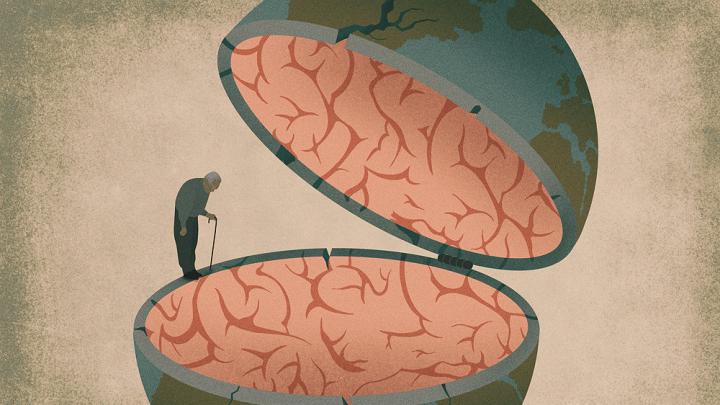Public-health officials have for years been warning of a coming “gray wave” of Alzheimer’s disease and other forms of dementia. Today, an estimated 47 million people worldwide live with the disorder. That cohort is expected to triple in the next three decades, while many millions more, watching older family members struggle with mental deterioration, have their lives upended emotionally. And dementia’s impact on public-health and household finances is similarly enormous: an estimated $305 billion in the United States during 2020 alone. Worldwide, dementia costs more than 1 percent of global GDP: $818 billion in 2015, according to a recent study.
But there is a surprising piece of good news: a declining trend in new cases per capita, during the last three decades, in Europe and North America. An August paper in Neurology, with Kay family professor of public health and clinical epidemiology Albert Hofman as lead author, points out the possible implications for public health around the globe, even as the prevalence of dementia cases rises with increasing life expectancy (age is the greatest risk factor), and incidence remains stubbornly high in many regions, or is actually rising, as in China and Nigeria. (Prevalence and incidence refer, respectively, to the proportion of the population with a disease at a given time, and to the rate of occurrence of new cases.)
“This is a very important observation, not only in its own right but, of course, to find out the reasons for this decline,” says Hofman, who also chairs the department of epidemiology at the Harvard T.H. Chan School of Public Health. The research also reveals another major finding: although women are commonly thought to be at higher risk of developing dementia, the scientists found that the underlying incidence rate is identical for men and women. (Dementia’s prevalence among women reflects their generally longer life spans.)
Analyzing data from 49,202 individuals across several decades and combining information from seven participating studies, the paper documented a 13 percent decline per decade in the dementia incidence rate in Europe and North America during the past quarter-century, with similar results for Alzheimer’s disease (the most common form of dementia).
The cause is unlikely to be genetic, Hofman says. Although more than 30 genes are tentatively correlated with Alzheimer’s disease, scientists believe their role is very limited. The three genetic mutations most strongly related to the occurrence of dementia, when combined, exist in less than 0.5 percent of cases, while another gene, APOE, exists in roughly 10 percent of all cases. The other genetic variants have smaller effects.
Increased access to education may underlie declining rates of dementia.
Instead, he offers two main hypotheses to explain the phenomenon, both focusing on environmental factors. The first is improved management of cardiovascular risks, such as hypertension, high cholesterol, and smoking. During the past 20 years, improved medications (such as statins), as well as programs in the United States and Europe to discourage smoking and encourage lifestyle changes that decrease high blood pressure and cholesterol, have played a substantial role in limiting these factors. Such efforts have not been deployed as successfully in many other parts of the world. Hofman warns, however, that the increase in body-mass index and the prevalence of diabetes in Western countries “certainly has not helped” in reducing dementia and Alzheimer’s.
The physiological mechanism relating cardiovascular risk factors to dementia, he says, “is not altogether clear.” A strong possibility, however, is that hypertension and other cardiovascular complications might damage small blood vessels leading to the brain, which he calls “a very strong predictor of dementia” because the resulting chronic decreased blood flow within the brain can lead to the death of neurons. That lack of perfusion and changes to blood vessels throughout the body may also interact with other mechanisms that lead to increased presence of amyloid and tau proteins, which often accumulate in the brains of people with Alzheimer’s and other forms of dementia.
A second hypothesis posits that declining rates of dementia can be attributed to increased access to education and higher levels of educational attainment in Europe and the United States. The theory, supported by limited evidence, holds that more education adds to a person’s “brain reserve,” which can delay the onset of Alzheimer’s disease. But Hofman notes that if improved education helps lower rates of cognitive decline, such changes would have occurred many years ago.
Future research will be needed to document any relationships between these hypotheses and the declining rates of dementia. If a causal relationship were uncovered, dementia-prevention programs might improve millions of lives. For now, though, Hofman believes the threat of dementia may provide people with much stronger motivation to safeguard their cardiovascular health, because “There are few things that people fear more than dementia and Alzheimer’s disease.” Yet his study, he adds, suggests fear should not turn into fatalism: “Don’t be too pessimistic. We can do something about this problem, because clearly we appear to be doing something right."







